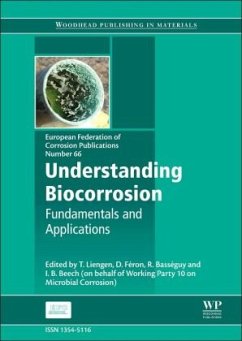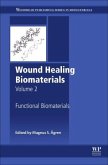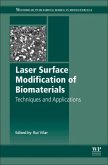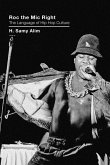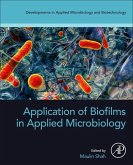- Gebundenes Buch
- Merkliste
- Auf die Merkliste
- Bewerten Bewerten
- Teilen
- Produkt teilen
- Produkterinnerung
- Produkterinnerung
Biocorrosion refers to corrosion influenced by bacteria adhering to surfaces in biofilms. Biocorrosion is a major problem in areas such as cooling systems and marine structures where biofilms can develop. This book summarises key recent research in this subject. Part one looks at theories of biocorrosion and measurement techniques. Part two discusses how bacteria and biofilms result in biocorrosion. The final part of the book includes case studies of biocorrosion in areas as diverse as buildings, fuels, marine environments and cooling systems.
Andere Kunden interessierten sich auch für
![Microbial Biofilms Microbial Biofilms]() Microbial Biofilms155,99 €
Microbial Biofilms155,99 €![Wound Healing Biomaterials - Volume 2 Wound Healing Biomaterials - Volume 2]() Wound Healing Biomaterials - Volume 2224,99 €
Wound Healing Biomaterials - Volume 2224,99 €![Materials for Ultra-Supercritical and Advanced Ultra-Supercritical Power Plants Materials for Ultra-Supercritical and Advanced Ultra-Supercritical Power Plants]() Materials for Ultra-Supercritical and Advanced Ultra-Supercritical Power Plants213,99 €
Materials for Ultra-Supercritical and Advanced Ultra-Supercritical Power Plants213,99 €![Laser Surface Modification of Biomaterials Laser Surface Modification of Biomaterials]() Laser Surface Modification of Biomaterials154,99 €
Laser Surface Modification of Biomaterials154,99 €![Roc the Mic Right Roc the Mic Right]() H. Samy Alim (UCLA and USA New York University)Roc the Mic Right72,99 €
H. Samy Alim (UCLA and USA New York University)Roc the Mic Right72,99 €![Mic It! Mic It!]() Ian CorbettMic It!60,99 €
Ian CorbettMic It!60,99 €![Application of Biofilms in Applied Microbiology Application of Biofilms in Applied Microbiology]() Application of Biofilms in Applied Microbiology135,99 €
Application of Biofilms in Applied Microbiology135,99 €-
-
-
Biocorrosion refers to corrosion influenced by bacteria adhering to surfaces in biofilms. Biocorrosion is a major problem in areas such as cooling systems and marine structures where biofilms can develop. This book summarises key recent research in this subject. Part one looks at theories of biocorrosion and measurement techniques. Part two discusses how bacteria and biofilms result in biocorrosion. The final part of the book includes case studies of biocorrosion in areas as diverse as buildings, fuels, marine environments and cooling systems.
Produktdetails
- Produktdetails
- European Federation of Corrosion (EFC) Series Volume 66
- Verlag: Elsevier Science & Technology / Woodhead Publishing
- Artikelnr. des Verlages: C2013-0-16468-9
- Englisch
- Abmessung: 24mm x 152mm x 229mm
- Gewicht: 818g
- ISBN-13: 9781782421207
- Artikelnr.: 41863415
- Herstellerkennzeichnung Die Herstellerinformationen sind derzeit nicht verfügbar.
- European Federation of Corrosion (EFC) Series Volume 66
- Verlag: Elsevier Science & Technology / Woodhead Publishing
- Artikelnr. des Verlages: C2013-0-16468-9
- Englisch
- Abmessung: 24mm x 152mm x 229mm
- Gewicht: 818g
- ISBN-13: 9781782421207
- Artikelnr.: 41863415
- Herstellerkennzeichnung Die Herstellerinformationen sind derzeit nicht verfügbar.
- List of contributors
- Series introduction
- Volumes in the EFC series
- Preface
- Part One: Turbomachinery Development
- 1: Understanding corrosion: basic principles
- 1.1 Introduction
- 1.2 Materials and surfaces
- 1.3 Basic corrosion processes
- 1.4 Main forms of corrosion degradation
- 1.5 Conclusion
- 2: Biofilms and biocorrosion
- 2.1 Introduction
- 2.2 Biofilms
- 2.3 Corrosion and biocorrosion
- 2.4 Molecular techniques for the investigation of biofilm communities
- 2.5 DNA microarrays
- 2.6 Mass spectrometric metabolomics for the study of biofilm-influenced corrosion
- 2.7 Conclusions
- Acknowledgements
- 3: Molecular methods for studying biocorrosion
- 3.1 Introduction
- 3.2 Requirements for molecular biological studies
- 3.3 Molecular methods based on the analysis of the 16S- and 18S-rRNA gene sequences
- 3.4 Functional genes as a molecular tool
- 3.5 Other useful methods
- 4: Sulphate-reducing bacteria (SRB) and biocorrosion
- 4.1 Introduction
- 4.2 Microbially induced corrosion (MIC)
- 4.3 Sulphate-reducing bacteria (SRB): bringing together hydrogen, sulphur and nitrogen biocycles
- 4.4 Electron transfer (ET) processes relevant for SRB
- 4.5 Bacteria and metal surfaces: influence of extracellular polymeric substances (EPSs)
- 4.6 Useful methods and tools for MIC assessment
- 4.7 Conclusions
- Acknowledgements
- 5: Electroactive biofilms
- 5.1 Introduction
- 5.2 Different types of electron transfer mechanisms
- 5.3 Examples of electroactive biofilms (EABs) from the lab
- 5.4 EABs and technological applications
- 5.5 EABs and biocorrosion
- 5.6 Conclusions
- 6: Immobilization and trapping of living bacteria and applications in corrosion studies
- 6.1 Introduction
- 6.2 Materials and methods
- 6.3 Immunoimmobilization, trapping bacteria and applications
- 6.4 BiyoTrap and applications
- 6.5 Conclusions
- Acknowledgements
- 1: Understanding corrosion: basic principles
- Part Two: Evaluating and modelling biocorrosion
- 7: Physical and local electrochemical techniques for measuring corrosion rates of metals
- 7.1 Introduction
- 7.2 Global measurement of corrosion rate
- 7.3 Electrochemical techniques for monitoring generalized corrosion
- 7.4 Electrochemical techniques for monitoring localized corrosion
- 7.5 Conclusions
- 8: Surface analysis techniques for investigating biocorrosion
- 8.1 Introduction
- 8.2 X-ray photoelectron spectroscopy (XPS) analysis
- 8.3 Time-of-flight secondary ion mass spectrometry (ToF-SIMS) analysis
- 8.4 Combining different analysis techniques
- 8.5 Conclusions
- 9: Modelling long term corrosion of steel infrastructure in natural marine environments
- 9.1 Introduction
- 9.2 Models and modelling
- 9.3 Models for corrosion
- 9.4 Factors involved in marine corrosion
- 9.5 Microbiologically influenced corrosion (MIC)
- 9.6 Corrosion loss model
- 9.7 Effects of nutrient pollution
- 9.8 Accelerated low water corrosion (ALWC)
- 9.9 Evaluating the effect of nutrient pollution
- 9.10 Conclusions
- Acknowledgements
- 10: Modeling mechanisms in biocorrosion
- 10.1 Introduction
- 10.2 Corrosion diagrams
- 10.3 Interfacial changes due to microbially influenced corrosion (MIC)
- 10.4 Localized corrosion
- 10.5 Modeling
- 10.6 Conclusions and recommendations
- 7: Physical and local electrochemical techniques for measuring corrosion rates of metals
- Part Three: Case studies
- 11: Biodeterioration of concrete, brick and other mineral-based building materials
- 11: Biodeterioration of concrete, brick and other mineral-based building materials
- List of contributors
- Series introduction
- Volumes in the EFC series
- Preface
- Part One: Turbomachinery Development
- 1: Understanding corrosion: basic principles
- 1.1 Introduction
- 1.2 Materials and surfaces
- 1.3 Basic corrosion processes
- 1.4 Main forms of corrosion degradation
- 1.5 Conclusion
- 2: Biofilms and biocorrosion
- 2.1 Introduction
- 2.2 Biofilms
- 2.3 Corrosion and biocorrosion
- 2.4 Molecular techniques for the investigation of biofilm communities
- 2.5 DNA microarrays
- 2.6 Mass spectrometric metabolomics for the study of biofilm-influenced corrosion
- 2.7 Conclusions
- Acknowledgements
- 3: Molecular methods for studying biocorrosion
- 3.1 Introduction
- 3.2 Requirements for molecular biological studies
- 3.3 Molecular methods based on the analysis of the 16S- and 18S-rRNA gene sequences
- 3.4 Functional genes as a molecular tool
- 3.5 Other useful methods
- 4: Sulphate-reducing bacteria (SRB) and biocorrosion
- 4.1 Introduction
- 4.2 Microbially induced corrosion (MIC)
- 4.3 Sulphate-reducing bacteria (SRB): bringing together hydrogen, sulphur and nitrogen biocycles
- 4.4 Electron transfer (ET) processes relevant for SRB
- 4.5 Bacteria and metal surfaces: influence of extracellular polymeric substances (EPSs)
- 4.6 Useful methods and tools for MIC assessment
- 4.7 Conclusions
- Acknowledgements
- 5: Electroactive biofilms
- 5.1 Introduction
- 5.2 Different types of electron transfer mechanisms
- 5.3 Examples of electroactive biofilms (EABs) from the lab
- 5.4 EABs and technological applications
- 5.5 EABs and biocorrosion
- 5.6 Conclusions
- 6: Immobilization and trapping of living bacteria and applications in corrosion studies
- 6.1 Introduction
- 6.2 Materials and methods
- 6.3 Immunoimmobilization, trapping bacteria and applications
- 6.4 BiyoTrap and applications
- 6.5 Conclusions
- Acknowledgements
- 1: Understanding corrosion: basic principles
- Part Two: Evaluating and modelling biocorrosion
- 7: Physical and local electrochemical techniques for measuring corrosion rates of metals
- 7.1 Introduction
- 7.2 Global measurement of corrosion rate
- 7.3 Electrochemical techniques for monitoring generalized corrosion
- 7.4 Electrochemical techniques for monitoring localized corrosion
- 7.5 Conclusions
- 8: Surface analysis techniques for investigating biocorrosion
- 8.1 Introduction
- 8.2 X-ray photoelectron spectroscopy (XPS) analysis
- 8.3 Time-of-flight secondary ion mass spectrometry (ToF-SIMS) analysis
- 8.4 Combining different analysis techniques
- 8.5 Conclusions
- 9: Modelling long term corrosion of steel infrastructure in natural marine environments
- 9.1 Introduction
- 9.2 Models and modelling
- 9.3 Models for corrosion
- 9.4 Factors involved in marine corrosion
- 9.5 Microbiologically influenced corrosion (MIC)
- 9.6 Corrosion loss model
- 9.7 Effects of nutrient pollution
- 9.8 Accelerated low water corrosion (ALWC)
- 9.9 Evaluating the effect of nutrient pollution
- 9.10 Conclusions
- Acknowledgements
- 10: Modeling mechanisms in biocorrosion
- 10.1 Introduction
- 10.2 Corrosion diagrams
- 10.3 Interfacial changes due to microbially influenced corrosion (MIC)
- 10.4 Localized corrosion
- 10.5 Modeling
- 10.6 Conclusions and recommendations
- 7: Physical and local electrochemical techniques for measuring corrosion rates of metals
- Part Three: Case studies
- 11: Biodeterioration of concrete, brick and other mineral-based building materials
- 11: Biodeterioration of concrete, brick and other mineral-based building materials

